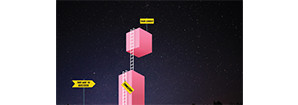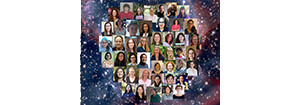Spotlight

Science News/Links at Steward
Three very recent science articles by/about Steward people. If you have one, send it to edo.
1) ASTROBITES: Samantha Scibelli & Yancy Shirley, "COMs in Cores: Complex Chemistry in Dense Cores in the Taurus Star-Forming Region". LINK HERE.
2) Chris Impey, "the Conversation." "Coronavirus: Social distancing is delaying vital scientific research." LINK HERE.
3) Chris Impey, "the Conversation," How technology can combat the rising tide of fake science." LINK HERE.
The photo is from Adam Block. You can see it and others HERE.

Jinyi Yang Will Be Our Second Strittmatter Fellow
We are pleased to announce that Dr Jinyi Yang, who has been a Postdoctoral Research Associate at Steward since late 2017, is going to become (Fall 2020) Steward's second Peter A. Strittmatter Fellow, succeeding Dr. Taran Esplin. You can read about the fellowship HERE.
Jinyi has kindly provided a brief synopsis of her current scientific projects:
"My main interests include the study of reionization-era quasars, of the history of reionization, and of early super-massive black holes (SMBHs). I am currently working on a wide-field survey for quasars with redshifts beyond seven, which has yielded the discovery of a new redshift record breaking quasar, and performing the multi-wavelength follow up observations of these distant systems, from X-ray to radio wavelengths. As a Strittmatter Fellow, I will focus on the investigations of the reionization history at the redshift range z~6-7.5 and the SMBHs growth using our newly constructed z>~7 quasar sample, the first large statistical significant quasar sample in the reionization epoch. In addition, I will use ALMA high resolution imaging to directly measure the BH masses of the ultra luminous individuals and study the BH-host interaction in the central region surrounding the maximally accreting black hole. My on-going/future HST and JWST projects will also allow me to give deep insights into the early SMBHs and their host galaxies."

UArizona COVID-19 Information
Since we now have the big featured article on www.as.arizona.edu we thought it would be nice to put up some links to other things here. Because of staffing issues we aren't changing the title of this page.
1)Samantha Scibelli & Yancy Shirley's paper on Astrobites : "COMs in Cores: Complex Chemistry in Dense Cores in the Taurus Star-Forming Region"
2) Two Chris Impey papers on "The Conversation" HERE and HERE. Titles are "Coronavirus: Social distancing is delaying vital scientific research," and "How technology can combat the rising tide of fake science"

SheTech Event Features High School Student Working With Steward Staff
Ellie Wolcott is a junior in the Engineering Program at Andrada High School from the Vail School District. She is featured at today’s SheTech Explorer Day at the Steward Observatory booth showing her telescope model. A blow-up of the photo is HERE. Ellie Wolcott, Kelly Merrill, and Kerry Gonzales are left to right.
In her internship, she has learned the SolidWorks design program and created a 3-D model of a 2 meter telescope. The scaled model of her design was 3-D printed and was featured at the Steward Observatory booth as shown below. She is one of the four students in the Steward Observatory High School Internship Program which is collaborating with the Vail School District.
Derek Langley is the Engineering instructor at Andrada High School who has helped to facilitate this and other dynamic experiences for his students and program. The Steward Observatory Staff supporting this effort is Kerry Gonzales, Mario Rascon, Kelly Merrill and Jeff Kingsley.
The City of Tucson Office of Economic Initiatives in partnership with UA Tech Parks Arizona is pleased to launch Arizona’s first SheTech Explorer Day! This day‐long, industry‐led STEM exploration event provides hands‐on, interactive activities in science, technology, engineering and math (STEM) for rising 9th through 12th grade girls.

TIMESTEP and Astrocharlas
The UArizona Research Innovation and Impact website has featured Astronomy/Steward's Dr. Gurtina Besla, the TIMESTEP program, and the Spanish-language lecture program, Astrocharlas, which is part of our venerable Monday Night Public Evening Series. You can read the article HERE.

Steward Celebrates UN International Day of Women and Girls in Science
February 11 was the UN International Day of Women and Girls in Science. We partially celebrate by creating and posting this collage of the women scientists here at Steward. A larger version of the collage can be seen HERE.
Pages

For Public
Public events include our Monday Night Lecture Series, world-reknowned Astronomy Camp and Mt Lemmon Sky Center.

For Students
A good place to start if you want to become an undergrad major or grad student, or need to find our schedule of classes.

For Scientists
Find telescopes and instruments, telescope time applications, staff and mountain contacts, and faculty and staff scientific interests.




